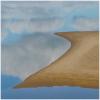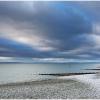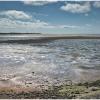
These photographs were made mainly in the river estuaries of Cumbria and north Lancashire, ranging from the Solway Firth in the north to the Kent valley and Morecambe Bay in the south. I'd imagined wide areas of flat clean sand with many sinuous channels and a quickly moving tide, and had expected to spend hour after hour on the sand photographing the shapes and play of light on those channels. .
But arriving at our Arnside base revealed a different picture. There was certainly a lot of flat clean sand; but channels were few and far between and access to the sand itself wasn't great. It took a while to work out a number of places where I could access or at least see onto the sand at different states of the tide. I'd been right about the fast-moving. These estuaries are massive. There's little point just setting out to walk any distance on them because there's little or no visible detail so no rationale to walk one way or another. Some of the sand looked as if it might be kind of gooey, and it was noticeable that bait diggers & dog walkers were pretty much absent. I took this to mean that maybe I should be absent too!
So most of these photographs were taken at mid-tide, rising or falling, because at low tide I had 100% sand or mud, and at high tide 100% water; yet it was the interplay of the two that I was after. Most were taken from spots raised a few feet above the sand to open up the view a little..
So eventually, over a week, I learned what might work and what clearly wouldn't. By the end I had some respectable photographs, though not necessarily those I had in my mind's eye when organising the trip. I find that happens a lot in photography.








































